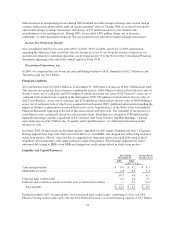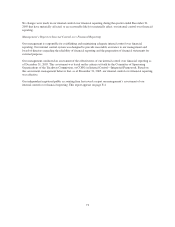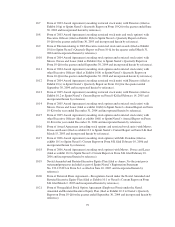Sprint - Nextel 2005 Annual Report Download - page 81
Download and view the complete annual report
Please find page 81 of the 2005 Sprint - Nextel annual report below. You can navigate through the pages in the report by either clicking on the pages listed below, or by using the keyword search tool below to find specific information within the annual report.• the market prices of our securities; and
• tax law restrictions related to the spin-off of Embarq that may limit our ability to raise capital from the
sale of our equity securities.
We have in the past and may in the future have discussions with third parties regarding potential sources of new
capital to satisfy actual or anticipated financing needs. At present, other than the existing arrangements that have
been consummated or are described in this report, we have no legally binding commitments or understandings
with any third parties to obtain any material amount of additional capital.
The entirety of the above discussion is subject to the risks and other cautionary and qualifying factors set forth
under “—Forward-Looking Statements” and Part I, Item 1A. “Risk Factors.”
Financial Strategies
General Risk Management Policies
We use derivative instruments only for hedging and risk management purposes. Hedging activity may be done
for purposes of mitigating the risks associated with an asset, liability, committed transaction or probable
forecasted transaction. We seek to minimize counterparty credit risk through stringent credit approval and review
processes, the selection of only the most creditworthy counterparties, continual review and monitoring of all
counterparties, and thorough legal review of contracts. We also control exposure to market risk by regularly
monitoring changes in hedge positions under normal and stress conditions to ensure they do not exceed
established limits.
Our board of directors has authorized us to enter into derivative transactions, and all transactions comply with
our risk management policies. We do not purchase or hold any derivative financial instrument for speculative
purposes.
Item 7A. Quantitative and Qualitative Disclosures about Market Risk
We are primarily exposed to the market risk associated with unfavorable movements in interest rates, foreign
currencies, and equity prices. The risk inherent in our market risk sensitive instruments and positions is the
potential loss arising from adverse changes in those factors.
Interest Rate Risk
The communications industry is a capital intensive, technology driven business. We are subject to interest rate
risk primarily associated with our borrowings. Interest rate risk is the risk that changes in interest rates could
adversely affect earnings and cash flows. Specific interest rate risk include: the risk of increasing interest rates on
short-term debt; the risk of increasing interest rates for planned new fixed rate long-term financings; and the risk
of increasing interest rates for planned refinancing using long-term fixed rate debt.
Cash Flow Hedges
We enter into interest rate swap agreements designated as cash flow hedges to reduce the impact of interest rate
movements on future interest expense by effectively converting a portion of our floating-rate debt to a fixed-rate.
As of December 31, 2005, we had no outstanding interest rate cash flow hedges.
Fair Value Hedges
We enter into interest rate swap agreements to manage exposure to interest rate movements and achieve an
optimal mixture of floating and fixed-rate debt while minimizing liquidity risk. The interest rate swap agreements
70
























